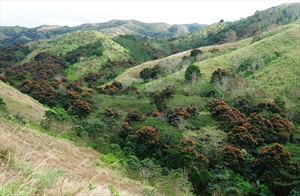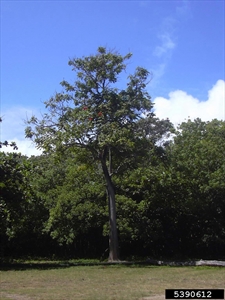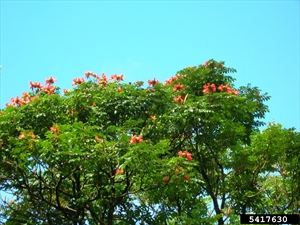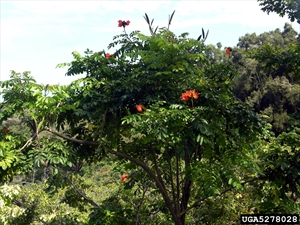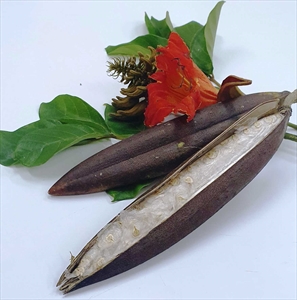African tulip tree. It is also known as fireball, or flame of the forest.
Pacific Pests, Pathogens and Weeds - Online edition
Pacific Pests, Pathogens & Weeds
African tulip tree (436)
Spathodea campanulata. It is a member of the Bignoniaceae.
Asia, Africa, North, South and Central America, the Caribbean, Europe (Spain), Oceania. It is recorded from American Samoa, Australia, Cook Islands, Federated States of Micronesia. Fiji, French Polynesia, Guam, Kiribati, Marshall Islands, Nauru, New Caledonia, Niue, Northern Mariana Islands, Palau, Papua New Guinea, Samoa, Tonga, Vanuatu, and Wallis and Futuna. It is native to tropical West Africa.
An invasive tree that rapidly colonises disturbed areas - along roadsides, waterways, and at forest margins - in tropical and sub-tropical regions. It is especially common along creeks and gullies, or in thick stands in wetter parts of the Pacific islands (Photo 1). It can tolerate dry seasons for up to 6 months, and grows in soils that are poorly or well drained. Its invasiveness is associated with the production of masses of wind-dispersed seeds and profuse suckering.
The trees grows to about 35 m, with spreading crown and slightly buttressed trunk (Photo 2). Leaves are compound, with 11-15 leaflets, up to 15 cm long, arranged in opposing pairs. Flowers occur in large dense clusters at the tips of branches (Photos 3&4). Individual flowers are enclosed in brownish boat-shaped sepals (about 5 cm long). The petals are reddish-orange, fused together and look somewhat like tulips (hence the name). Pollination is by birds, possibly bats. The seedpods are flattened, brown when mature and open releasing up to 500 light winged seeds (Photo 5).
The tree is particularly invasive in tropical islands of the Pacific and the Caribbean where it has been introduced because of its showy flowers. Spread over short distances by suckers. Spread over short and long distances by seed. Long-distance spread also favoured by movement in the international horticulture trade, and as a street tree.
The degree of 'weediness' of this tree has been argued in Pacific island countries over a number of years. Orapa1 summaries the arguments. There are some who consider the tree a positive addition to the flora. It quickly revegetates disturbed forests after fire in the absence of native species able to play that role. There is also a preference for the tree over fern on rugged hillsides.
The nectar of the flowers of the African tulip trees are toxic to native (stingless) bees, and kills them.
Some hold the view that the tree is viewed negatively only because it grows on land where crops have potential or native species might be growing.
However, negative impacts on biodiversity, as well as on agriculture and forestry, have been documented. For instance, in Fiji, Eastern Polynesia and some islands of the Bismarck Archipelago, Papua New Guinea, the tree grows aggressively, filling forest gaps through suckering and seed production allowing it to replace native hardwood species useful for building houses, canoes and other traditional wooden items. Further, African tulip trees are easily felled by storms, damaging homes, infrastructure, and people. The soft wood has little use, only for crates and shuttering.
The main use is as an ornamental tree, although the wood is used for crates and shuttering, the seeds for food and plant extracts in traditional medicines. It is also used to rehabilitate degraded areas, and there is some use as a fodder.
BIOSECURITY
Where this tree is invasive, consider regulations to prevent its distribution unless authorised. It is among 100 of the World's Worst Invasive Alien Species compiled by the Global Invasive Species Database, maintained by the IUCN Invasive Species Specialist Group, 2020.
Spathodea campanulata is a restricted invasive plant under biosecurity acts in some parts of Australia; this means - a person must not release these invasive plants into the environment, give away or sell as a plant or something infested with its seeds.
BIOCONTROL
The three most common species according to CABI are: Acherontia lachesis (greater death's head hawkmoth), Hyblaea puera (teak defoliator, see Fact Sheet no. 435), and Psilogramma menephron (privet moth). Biological control using an isolate of the fungus, Ceratocystis, is reported from Cuba, killing trees in coffee plantations.
CULTURAL CONTROL
Pull out or dig out young seedlings. However, this is only effective if the trees are young when it is possible to remove the entire root system. Otherwise, suckers regrow from the roots.
CHEMICAL CONTROL
In Australia, the following are registered: triclopyr + picloram; triclopyr + picloram + aminopyralid; glyphosate (and Fiji).
All used to frill (chop off the bark to cut into the wood) or inject.
- The first two also used in cut stump treatments, or
- To paint the base of the trees to a height of 30 cm from the ground.
- In Palau, undiluted triclopyr or glyphosate is poured into notches cut 2.5 cm deep into the cambium around the stem.
--------------------
Note, EU approval to use glyphosate ends in December 2022; its use after that date is under discussion.
____________________
When using a pesticide, always wear protective clothing and follow the instructions on the product label, such as dosage, timing of application, and pre-harvest interval. Recommendations will vary with the crop and system of cultivation. Expert advice on the most appropriate herbicides to use should always be sought from local agricultural authorities.
AUTHORS Grahame Jackson & Aradhana Deesh
1Information from Warea Orapa (2017) Impact and management of invasive alien plants in Pacific island communities. In: Ellison CA, et al. (eds) Invasive Alien Plants. CAB International. (https://www.cabi.org/ISC/FullTextPDF/2017/20173322107.pdf); and African tulip tree Spathodea companulata. Brisbane City Council weed identification tool. (https://weeds.brisbane.qld.gov.au/weeds/african-tulip-tree); and Weeds of Australia, Biosecurity Queensland Edition. Queensland Government. (https://keyserver.lucidcentral.org/weeds/data/media/Html/spathodea_campanulata.htm); and from Spathodea campanulata (African tulip tree) (2019). CABI Invasive Species Compendium. (https://www.cabi.org/isc/datasheet/51139). Photos 1,3&5 Forest and Kim Starr, Starr Environmental, Bugwood.org. Photo 4 Joy Viola, Northeastern University, Bugwood.org. Photo 6 Tony Pernas, USDI National Park Service, Bugwood.org.
Produced with support from the Australian Centre for International Agricultural Research under project HORT/2016/185: Responding to emerging pest and disease threats to horticulture in the Pacific islands, implemented by the University of Queensland and the Secretariat of the Pacific Community.

